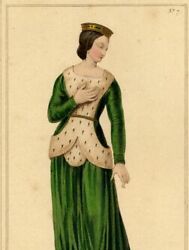#isabeau de bavière
Text
Maybe an unpopular opinion but I wish they would finally stop only making movies and series of the tragic life of Sisi (Empress Elizabeth in Bavaria) and look for other interesting royal German/ Austrian or German speaking ladies/ queens like for example Queen Luise of Prussia (and her sister Charlotte, both being from the house of the dukes of Mecklenburg-Strelitz and having very interesting lifes) or Isabelle/ Elisabeth, called "Isabeau de Bavière" (from the House of Wittelsbach-Ingolstadt), wife of the so called mad French King Charles VI, mother of King Charles VII and Queen Catherine of England (first wife of Henry V of England, then married to Owen Tudor and mother of Henry VI).
Or St. Elizabeth of Thuringia/ Hungary who lived a life for the poor after she lost her husband, Ludwig/ Louis IV, the landgrave of Thuringia, in the 6th crusade (1227) and is among the most renowned Catholic saints.
I would also name Catherine the Great of Russia (Sophie of Anhalt-Zerbst) but there is a Russian series about her life and the one with Helen Mirren.
Then the famous St. Hildegard of Bingen, a famous and influential woman of the Middle Ages to this day in so many ways. Yes, there was a German movie about her some years ago but I don't think that it is widely known.
Then "Liselotte von der Pfalz" as Germans do call her, the Madame Palatine, wife of Philippe of Orlèans, brother of King Louis XIV aka the "sun king". She wrote a tremendous amont of letters in her life, leaving behind so much information about the court of the "sun king" that historians can only be thankful to her. Yes, there was the series "Versailles" but that wasn't quite an accurate one.
At least Maria Theresia of Austria, mother of Queen Marie Antoinette and King Joseph II got a series some years ago, cause let us face it, that woman was a great one. As a child it always impressed me wildly how many children she and Luise of Prussia got. It seemed insane to me.
With this I want to say: There is more got stuff about great German/ Austrian/ German speaking ladies out there. Wayyyy more.
And it angers me that it does not get depicted.
Only our tragic or as "weak/ bad" considered ladies do get some recognition like Sisi, Marie Antoinette or Tsarina Alice of Hesse. That is sad.
https://en.m.wikipedia.org/wiki/Isabeau_of_Bavaria
https://en.m.wikipedia.org/wiki/Elizabeth_of_Hungary
#the empress#elizabeth of austria#empress sisi#luise of prussia#charlotte of prussia#st. elizabeth of thuringia#st.elizabeth of hungary#isabeau de bavière#catherine the great
20 notes
·
View notes
Text
I had totally forgotten this event’s devils were the ones with the absolute worst Isabeau battle I had last year.
I can’t believe I have to go through 89 turns to defeat the hoe AGAIN cuz guess what bitch…
In a whole year, I didn’t get anything that’s any better than what I had last year.
So it’s solo Vampire Kanagi until the end bitch.
Work.
13 notes
·
View notes
Text
I think no one has pointed this yet
I was watching the episodes from the actual event "Romance is[triangle], love is[circle]" when paid attention...

And I was "omfg"
Then I was... Hehe

6 notes
·
View notes
Text
#xiv#xv#valentine visconti#house visconti#duchesse d'orléans#armagnacs vs bourguignons#hundred years war#louis i d'orléans#charles vi#isabeau de bavière#charles d'orléans#jean d'orléans#philippe d'orléans#marguerite d'orléans
0 notes
Text

La Mode illustrée, no. 38, 18 septembre 1864, Paris. Robes de ville de Melle Rabois, r. Nve. des Pts. Champs, 67. Ville de Paris / Bibliothèque Forney
Description de toilettes:
Robe en reps de soie côtelé, de nuance gris-feutre, faite en forme de robe Princesse ou Isabeau de Bavière. Le bord inférieur de la jupe est garni avec une bande en velours de même nuance que la robe, ayant 3 centimètres de largeur. Au-dessus de cette bande, se trouve une assez large guirlande de feuilles de chêne et de glands, exécutée en chenille de même nuance que.la robe; cette guirlande remonte sur chaque côté, par devant, jusqu'au cou, en diminuant de proportions; elle remonte aussi sur chaque couture réunissant les lés. Devant, cette dernière guirlande remonte sur un espace de 50 centimètres; de côté, sur un espace de 40 centimètres; derrière, sur un espace de 30 centimètres. Manches étroites, ornées de la même guirlande, qui remonte vers le coude.
Robe en taffetas bleu vif, moucheté de noir. Sur le bord inférieur de la jupe, les lés sont séparés sur une hauteur de' 30 centimètres, repliés de chaque côté, et ces sortes de revers sont garnis avec une dentelle noire. L'espace vide qui se trouve entre les revers est rempli par une pointe de même étoffe que la robe, couverte d'un treillage en rubans de velours noir. Corsage plat, montant, à pointe, orné par devant avec un treillage de velours noir. Manches étroites, garnies comme la robe. Chapeau de tulle bleu, mélangé de dentelle noire.
—
Dress in ribbed silk rep, in a felt-grey shade, made in the shape of a Princess or Isabeau of Bavaria dress. The lower edge of the skirt is trimmed with a velvet band of the same shade as the dress, 3 centimeters wide. Above this band is a fairly large garland of oak leaves and acorns, made of chenille of the same shade as the dress; this garland goes up on each side, from the front, to the neck, decreasing in proportion; it also goes up on each seam joining the strips. In front, this last garland goes back over a space of 50 centimeters; sideways, over a space of 40 centimeters; behind, over a space of 30 centimeters. Narrow sleeves, decorated with the same garland, which goes up towards the elbow.
Dress in bright blue taffeta, speckled with black. On the lower edge of the skirt, the strips are separated to a height of 30 centimeters, folded on each side, and these types of lapels are trimmed with black lace. The empty space between the lapels is filled with a point of the same fabric as the dress, covered with a latticework of black velvet ribbons. Flat, high, pointed bodice, decorated on the front with a black velvet trellis. Narrow sleeves, trimmed like the dress. Blue tulle hat, mixed with black lace.
#La Mode illustrée#19th century#1860s#1864#on this day#September 18#periodical#fashion#fashion plate#color#description#Forney#dress#Modèles de chez#Mademoiselles Rabouin
33 notes
·
View notes
Text

“Vase Antique à Têtes de Satyre" dit "Vase Rubens" gravure de Paul Pontius d'après Pierre Paul Rubens (1640-58) du vase en agate sculpté à la fin de l'Antiquité, offert par la Reine Isabeau de Bavière au Trésor de Notre-Dame (1425) et racheté par le peintre Rubens (1619) présenté à l'exposition “Le Trésor de Notre-Dame de Paris - Des Origines à Viollet-Le-Duc” au Louvre, décembre 2023.
8 notes
·
View notes
Video
youtube
Magical Girl Story: Isabeau de Bavière (Witch ver.)
Translation Credits: Ashes
10 notes
·
View notes
Photo

Bibliographic Record
Author
Bearne, Mrs. (Catherine Mary Charlton), -1923
Illustrator
Bearne, Edward H.
LoC No.
46038469
Title Pictures of the old French court
Jeanne de Bourbon, Isabeau de Bavière, Anne de Bretagne
Language English
LoC Class
DC: History: General and Eastern Hemisphere: France, Andorra, Monaco
Subject
Jeanne de Bourbon, Queen, consort of Charles V, King of France, 1335-1378
Subject
Isabella, Queen, consort of Charles VI, King of France, 1370-1435
Subject
Anne, of Brittany, Queen, consort of Louis XII, King of France, 1476-1514
Category Text
EBook-No.50052
Release Date Sep 25, 2015
Copyright Status Public domain in the USA.
20 notes
·
View notes
Text
idk how they would make isabeau nearly identical to the real isabeau of bavaria


but give melissa a victorian maid’s uniform which was 400 years off



i’m gonna lose my mind
#mine#tart magica#melissa de vignolles#isabeau de bavière#historical fiction#historical inaccuracies#magia record
114 notes
·
View notes
Text

A drawing of Isabeau to brighten your day!
Coloring the background was very no thoughts head empty and it was very fun!
#fanart#magia record#tart magica#puella magi tart magica#isabeau de bavière#I hate the color yellow so much#when I read the manga I thought she had Kyube’s color pallet because of her wish#I was very disappointed when she didn’t
60 notes
·
View notes
Photo

✧・゚:*Today’s magical girl of the morning is: Isabeau from Puella Magi Tart Magica: The Legend of "Jeanne d'Arc"!✧・゚:*
#Isabeau de Bavière#Isabeau#Puella Magi Tart Magica: The Legend of Jeanne d'Arc#manga#blonde#yellow#magical girl#dark magical girl#magical girl of the day#mahou shoujo
35 notes
·
View notes
Text
NEW UNIT ANNOUNCED
Isabeau de Bavière



I think I can get on board with this disc set. It's the same as Minou's.
#Isabeau de Bavière#Magia Record#Puella Magi Tart Magica#Puella Magia Madoka Magica#Puella Magi Madoka Magica Side Story#PMMM#Magical Girl#Gacha Game#Anime#Tart Nation
48 notes
·
View notes
Text
Many fans of Isabeau of Bavaria as depicted in Tart Magica can appreciate her for the evil, powerful woman she is. However, at least in my friend’s case, what makes her even more appealing is all the stuff leading up to it. That she WASN’T always that way. As depicted in Magia Record, she dreamed of being a mother. And of course, then, you get the stuff in history that still applies to her. Meaning yes, contrary to what Wikipedia will tell you, Charles VI was an awful person even before his mental illness overwhelmed him. “Passionately in love,” does become hard to believe when Izzy was 14 at the time they met, couldn’t really speak French (she spoke French with a clear accent the rest of her life), and had thought she was being sent on a religious journey at first. Basically, if you really do some digging? While Isabeau is way more outright evil than her, like Homura, much of what led her to becoming what she is was lashing out at a cruel, unjust world…
For more information, @crepusculereine will be more than happy to share her research! She also does art!

23 notes
·
View notes
Text
Isabeau and Pernelle's general stats:


News translated by Magia Union Translations Discord, not the owner of this blog.
#Isabeau de Bavière#Pernelle Flamel#Magia Record#Magia Record News#Magia Union Translations Discord#The Inheritors of Our Souls
17 notes
·
View notes
Text



Hahaha, yesss! I got the dark queen on my third paid gem thingy! Does that mean I still get a nat 4* on roll 5?
I really love her voice lines in this unit tho, she sounds so much more alive! Not hard to do when every other word you utter is some lifeless form of “die”.
#magia record#isabeau de bavière#magical girl ver#I’m still going for Perenelle#need all the void types
11 notes
·
View notes
Text
The campaign of propaganda against Valentina Visconti
Irritated by her sister-in-law's calming effect upon the troubled king (while she was rebuffed frequently by him), it seems that Isabeau set to besmirching Valentina's good reputation. Valentina was Italian, and, "as everyone knew", Italy was a nation of poisoners and sorcerers. Charles's illness was reinterpreted; no longer a judgement upon the behavior of his uncles or the misgovernment of his advisers, the unfortunate king was recast as the victim of Valentina's sorcery and enchantment. A rumor started to circulate to the effect that Valentina had bewitched the king; she was the cause of his illness and the obstacle to its cure. As it was rumor there was no need to prove such a claim; its mysterious nature bilked direct proof or formal demonstration, and Valentina's enemies were able to condemn her without a tribunal. To this a concomitant rumor was pressed into service: the classic tale of a poisoned apple and the death of a little prince. Valentina's enemies leapt into the fray to exploit the sad death of her young son Louis in September 1395. It was whispered that she had planned to remove the young dauphin but that instead her own son, who was playing with the other royal children, ate the tainted fruit and died of poisoning. The story was picked up by Froissart, keen to deride a woman whom he believed to be ambitious with aspirations above her station.

Ambitious Valentina is a them that crops up from this time and one that Jean the Fearless of Burgundy recycled on the occasion of his Justification for the murder of Orleans. It was a "known fact" (the rumor reported) that upon Valentina's departure from Milan to marry Louis of Orleans, her father, Giangaleazzo, bid her a fond farewell with the words: "Adieu, belle fille! je ne vous vueil jamais veoir tant que vous soyez royne de France." (Good-bye, beautiful daughter! I do not expect to see you again until you are queen of France!) [..]
Initiated by the rumor of evil spells linked to and fueled by the "known" sorcery habits and nefarious aspirations of Valentina's father, Isabeau's bespoke campaign of propaganda against her sister-in-law aimed to remove Valentina's considerable potential for influence by ensuring that she would have no further personal contact with the king, the princes, the people, the conduct of the business of the kingdom, or to take any action which might be contrary to Isabeau's projects and ambitions. Valentina was to be disloged from court, distanced from Paris, and relegated far beyond the center of political decision making. With Isabeau's campaign, Valentina was reduced to powerlessness and separated from the royal family and her allies. Eugène Jarry expresses well Isabeau's strategy:
"Isabeau did not forget the duchess of Orleans' influence over the mind of the king. Her plan was mapped out: it was absolutely necessary to remove the daughter of the duke of Milan. This outcome was achieved by the most cowardly of schemes. The outburst of negative public opinion against Valentina was too precise not to have been stirred up by interested parties."
Here Jarry links public opinion to interested parties. Isabeau was not the only interest party; the house of Burgundy carried its share of responsibility even though Burgundy was content enough to allow Orleans to divert himself with his Italian dreaming. Philippe was cordial and welcoming to Valentina, but his political reality dictated that he needed to work toward removing Orleans from all participation in government. Burgundy's wife, Marguerite of Dampierre, countess of Flanders, was of a mind to assist Isabeau in blackening Valentina's reputation. In taking control of the government in the wake of Charles's first episode of insanity, Burgundy had positioned Marguerite to steer the young queen in the interests of their House. From 1392, Marguerite jealously guarded her pre-eminent position in Isabeau's court, and no one could gain access to the queen without her consent.
[..]
Collas claims that Marguerite had been greatly put out by Valentina's arival and her subsequent drop in status; she was henceforth the middle-aged sister in law of the defunct king while Valentina was the cherished younger sister-in-law of the current king.
The mud stuck and, for her own safety, Orleans removed Valentina from court. Froissart records that such were the murmurings of the public that had Valentina not withdrawn she might have been attacked and lynched by a Parisian mob that believed she meant to poison the king and his children.
Zita Eva Rohr- True Lies and Strange Mirrors: the Uses and Abuses of Rumor, Propaganda and Innuendo During the Closing Stages of the Hundred Years War, in Queenship, Gender and Reputation in the Medieval and Early Modern West
#xiv#zita eva rohr#true lies and strange mirrors#isabeau de bavière#queens of france#charles vi#valentine visconti#louis i d'orléans#giangaleazzo visconti#jean i de bourgogne#marguerite de dampierre#armagnacs vs bourguignons#hundred years war#reputation and propaganda
7 notes
·
View notes